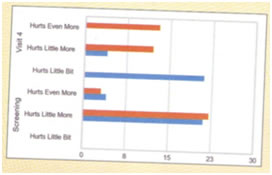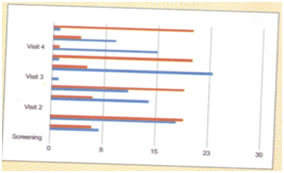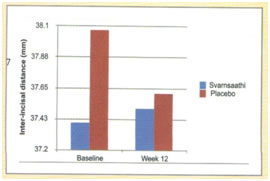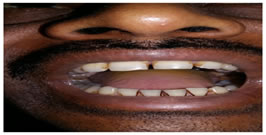Official Journals By StatPerson Publication
|
Table of Content - Volume 10 Issue 3 - June 2019
A randomised double blinded trial to evaluate the efficacy off curcumin in natural turmeric matrix in the treatment of oral submucous fibrosis - A study of 50 cases
Bhalchandra Paike1*, Anushree Bajaj2, Shehnaj Shaikh3, Vikrant Vaze4
1Professor,2Associate Professor, 3,4Senior Resident, Department of ENT, Dr. Ulhas Patil Medical College, Jalgaon, Maharashtra, INDIA. Email: bhalchandra.paike@gmail.com
Abstract Turmeric has been in use for thousands of years as a dye, flavouring and a Medicinal herb. Ancient Indian medicine has touted turmeric as an herb with the ability to provide glow and luster to the Skin as well as vigour and Vitality to the entire body. Since Curcumin has antimicrobial, antioxidant, astringents and other useful properties, it is quite useful in dentistry also. Curcumin, the most active polyphenolic constituent, is the active ingredient in the traditional herbal remedy and dietary spice turmeric. In gel form it is a Component in local drugs delivery system. The objective of this article is to review the pharmacological action of turmeric and its use in treating oral submucous fibrosis. Key Word: Antioxidant, Fibrinolytic, Herbal medicine, Naoparticles, Turmeric
INTRODUCTION Medicinal herbs have been used as treatment modalities since ages in many parts of the world and have been variedly used throughout human history. the most common natural product form such herbs used for medicinal purposes is polyphenols since it has the most anti - oxidant effect. Curcumin (diferuloylmethane) is a polyphenol compound isolated form ground rhizomes of the plant (curcuma longa) L. (zingiberaceae) found in south Asia1. curcumin is naturally occurring yellow pigment of turmeric having wide spectrum of biological action2. Curcumin has been used extensively in ayurvedic medicine for centuries, as it is nontoxic and has a variety of the properties including antioxidant, analgesic, anti-inflammatory, antiseptic activity, anticarcinogenic activity, chemopreventive, chemothearapeutic activity, anti-tumour, antiviral, antibacterial, antifungal properties and antiplatelet activity. Curcumin exhibits a big promise as a therapeutic-agents due to its properties and is currently in human trials for a variety of conditions like multiple myeloma, pancreatic cancer, colon cancer, mastitis myelodysplastic syndromes, psoriasis, Alzheimer’s disease, diabetic nephropathy, periodontal diseases, oral cancers, recurrent aphthous stomatitis, pre cancerous lesion
MATRIALS AND METHODS A total of 50 patients, who were diagnosed as suffering from mild OSMF (fibrous banding, blanching and leathery mucosa and inter-incisal opening between 34 and 40 mm) to moderate oral sub mucous fibrosis (fibrous banding, blanching and leathery mucosa) and interrincisal limitation of opening 25-33 mm.) were included in the study -patients with current or prior history of oral cancer, recent radiation therapy to the head or neck region and pregnant or lactating woman were excluded from the study. Total treatment duration was 12 weeks during which all subjects were closely monitored for protocol compliance and assessed for efficacy and safety parameters. The interincisal opening was one of the endpoint measurements and was measured at every visit by calibrated investigator while other efficacy endpoint were assessed by questionnaires. - Subjects were evaluated screening/pre-baseline (visit 0), Baseline / week 0 (visit 1), week 4 (visit 2), week 8 (visit 3), week 12 (visit 4), and week 24/ Telephonic follow up visit. They were posed to a number of questionnaires /visual analogue scales, as well as assessed for oral examinations (including measurement of mouth opening), dental prophylaxis and blood tests. All Subjects were counselled regularly against areca-nut, Gutkha and tobacco use. Adverse events were monitored throughout the Study period. - During screening, there were 16% patients with hurts, even more but by the end of 4th visit, none of the patient having that issue in treatment group a curcumin. But for treatment B (placebo), by end of study, it increased from 12% to 52%. For extent burning experience While having spicy, treatment A is working far better that treatment B. During screening, 72% of subjects were having severe burning in treatment group A, but by the end of visit 4, it came down to 4%. But in treatment B group, it increased from 76% to 80%. - Same with difficulty in opening mouth while having certain foods - 64 of subjects in treatment group A having severe difficulty during screening but it came down to 4% by end of visit.4 But in treatment group B, it increased from 72% to 84%. For treatment group A, severe dryness in mouth came down from 64% to 4% but in treatment group B, it increased from 68% to 88%. severe pain experience while having textured food in treatment group A came down from 64% to 48% whereas it increased form 64% to 92% in treatment group B. Discomfort during screening, but it came down to 4% by end of visit.4 But increased from 60% to 80% in treatment group B.
RESULTS A total 50 patients were in this study and the age range of >18 years:- From the below bar diagrams, during screening, 72% of subjects were having severe burring in treatment group A, but by visit end of the 4 it came down to 4% . But in treatment B group, it increased from 76% to 80%. Same with difficulty in opening mouth while having certain food - 64% of subjects in treatment group A having severe difficulty during screening but it came down to 4% by end of visit 4. but in treatment group B, it increased from 72% to 84%. For treatment Group A, severe dryness in mouth came down from 64% to 4 % but in treatment group B, it increased from B, it increased from 68% to 88%.
Figure 1: Figure2: Extent of burning experience while having spicy food Blue: svarnsaathi Orange: placebo
Figure 3: Difficulty in opening the mouth and preventing in having certain food (e.g., apple)?
Figure 4: Effect of IP on inter-incisal distance efficacy variable
The above bar diagram shows that there is an increase in the inter-incisal distance at the end of 12 weeks with curcumin treatment. In placebo group inter-incisal distance is reduced, suggesting the fact that absence off therapeutic treatment is further worsening the OSMF in this group. Figure 5: Image of patient with OSMF with trismus grade 3
DISCUSSION The current study confirms that treatment with curcumin is helpful to subside inflammation and ulceration, thus preventing further progress of OSMF, increases suppleness of the stiffed oral tissue in terms of improving mouth movements, reverses fibrosis to some extent and improves overall immunity which in turns increases the strength of oral mucosa and submucosa to overcome the disease. - This study observed increase in the inter-incisal distance at the end of 12 weeks, curcumin treatment though not statistically significant. Also, it did not further decrease as well, showing some beneficial effect on oral submucosa. Instead, in placebo group we could observe a reduction in inter-incisal distance, suggesting the fact that absence of therapeutic treatment is further worsening the OSMF in this group. Curcumin had worked better than placebo. - All clinical laboratory evaluation were assessed to evaluate the effect of ip on them at baseline and at the end of study visit (week,) the final study visit of the subject. both the treatments did not exhibit any major variations for any of the lab parameters so product - curcumin is considered as safe and didn’t have any adverse effects during the course of treatment.
CONCLUSION This can be concluded that treatment with curcumin is helpful to subside inflammation and ulceration and thus in preventing further progress of OSMF, increases suppleness of the stiffed oral tissue in terms of improving mouth movements, reverses fibrosis to some extent and improves over all immunity which in turns increases the strength of oral mucosa and submucosa to overcome the disease
REFERENCES
|
|
 Home
Home





